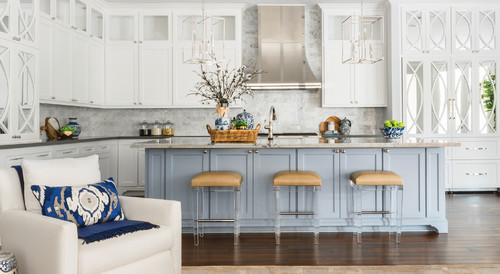How to Buy Kitchen Cabinets
Buying kitchen cabinets is a significant investment for any home renovation project. The process of buying cabinets can be overwhelming, with so many styles, materials, and finishes to choose from. But fear not, we’re here to help guide you through the process of how to buy kitchen cabinets. In this blog post, we’ll cover everything you need to know about buying cabinets, from measuring your space to selecting the perfect style to fit your needs and budget. So let’s dive in and get started!
A. Importance of Kitchen Cabinets in a Kitchen
Kitchen cabinets serve multiple purposes, primarily providing storage for dishes, utensils, cookware, and pantry items. By maximizing storage and organization, cabinets allow you to maintain a clutter-free workspace, creating a more efficient and enjoyable cooking environment. Additionally, kitchen cabinets have a significant impact on the visual appeal of your kitchen. As they often occupy a large portion of wall space, cabinets can set the tone and style for the entire room. Thus, making thoughtful choices when selecting your kitchen cabinets will not only improve functionality but also contribute to the overall ambiance of your space.
B. The Impact of Choosing the Right Cabinets on Your Kitchen’s Functionality and Aesthetics
Buying the right cabinets can make or break your kitchen’s design and utility. Cabinets that cater to your specific storage needs and preferences will simplify your daily routine and make your kitchen more user-friendly. Furthermore, well-chosen cabinets can enhance the aesthetics of your kitchen, seamlessly blending with other design elements and making a statement that reflects your personal style. In contrast, cabinets that do not meet your requirements or clash with your design vision can lead to frustration, inefficiency, and a less enjoyable cooking and dining experience.
C. Purpose of the Blog
The purpose of this blog is to provide a comprehensive guide to buying kitchen cabinets. We will explore various aspects of the cabinet selection process, including determining your budget and needs, selecting materials and styles, and evaluating features and storage solutions. By providing a detailed and professional overview of the process, this guide aims to help you make informed decisions when purchasing your new kitchen cabinets, ensuring that your investment will be well worth it for years to come.
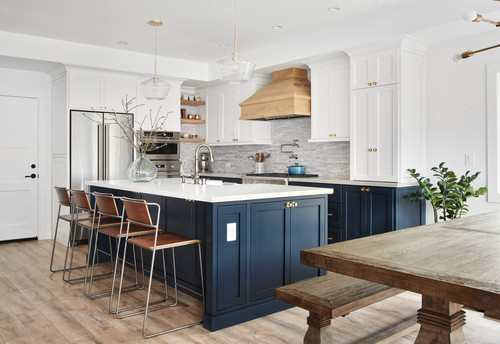
Determine Your Budget and Needs when Buying Cabinets
Before diving into the world of kitchen cabinets, it’s crucial to assess your budget and needs. This will help you make informed decisions throughout the selection process, ensuring that you buy cabinets that are both functional and aesthetically pleasing, while also remaining within your financial constraints.
A. Evaluate Your Financial Constraints
Determine how much you can afford to spend on your kitchen cabinets. It’s essential to be realistic about your budget, as cabinets can vary significantly in price based on factors such as materials, construction, and customization options. Keep in mind that cabinets typically account for a substantial portion of your overall kitchen remodeling budget, so allocating sufficient funds for this element is crucial.
B. Prioritize Functionality Versus Aesthetics
Consider the balance between functionality and aesthetics when buying cabinets. While it’s essential to choose cabinets that complement your kitchen’s design, it’s equally crucial to ensure they meet your storage and organization needs. Evaluate your priorities and decide whether you’re willing to compromise on appearance or function, or if you can find a balance that suits your requirements.
C. Understand the Importance of Quality in the Long Run
Investing in high-quality cabinets can save you money and hassle in the long term. While it might be tempting to cut costs by purchasing lower-quality materials or construction, these options may not stand the test of time, requiring more frequent replacements or repairs. When determining your budget, factor in the long-term value of quality craftsmanship and materials.
D. Identify Necessary Features and Storage Requirements
Take the time to assess your current kitchen storage and organization needs. Make a list of items you store in your cabinets and consider any additional requirements that may arise in the future. Consider features such as adjustable shelving, pull-out drawers, and specialized storage solutions for items like pots, pans, and small appliances. By identifying your specific needs, you’ll be better equipped to buy kitchen cabinets that cater to your unique storage and organizational preferences.
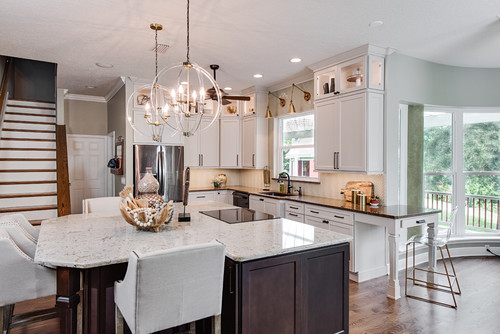
Choose the Right Material when Buying Cabinets
Selecting the appropriate material for your kitchen cabinets is a critical decision, as it will impact the durability, maintenance, budget, and overall appearance of your cabinets. In this section, we will explore common materials used in cabinet construction and discuss the pros and cons of each to help you make an informed decision.
A. Common Materials for Kitchen Cabinets
- Solid Wood: A popular choice for its natural beauty and durability, solid wood cabinets are available in various species, including oak, maple, cherry, and hickory. Wood cabinets can be stained or painted to suit your design preferences.
- Plywood: Composed of multiple layers of wood veneer, plywood is a strong and stable material for cabinet construction. Plywood cabinets are less prone to warping and are typically more affordable than solid wood options.
- Medium-Density Fiberboard (MDF): MDF is an engineered wood product made from wood fibers combined with resin and compressed under heat and pressure. MDF cabinets are known for their smooth surface, making them ideal for painting. They are also less susceptible to warping and tend to be more affordable than solid wood.
- Particleboard: Particleboard is made from wood particles mixed with resin and compressed into sheets. While it is the most budget-friendly option, particleboard cabinets are less durable and more susceptible to damage from moisture and wear and tear compared to other materials.
- Stainless Steel: For a sleek, contemporary look, stainless steel cabinets offer a modern, industrial appearance. They are highly durable, resistant to moisture and stains, and easy to clean. However, they can be expensive and prone to scratches and fingerprints.
B. Pros and Cons of Each Material
Each material has its advantages and disadvantages, and the best choice for your kitchen will depend on factors such as budget, style, and maintenance preferences. Consider the durability, maintenance requirements, and cost of each material when making your decision.
C. Factors to Consider When Selecting Material
- Durability: Consider the longevity of your chosen material and its ability to withstand daily wear and tear, moisture, and temperature fluctuations.
- Maintenance: Evaluate the maintenance requirements for each material, such as cleaning, refinishing, or repairing. For instance, solid wood cabinets may require more frequent refinishing, while stainless steel cabinets may need regular polishing to maintain their appearance.
- Budget: Factor in the cost of each material, taking into account not only the initial purchase price but also long-term maintenance and replacement costs.
- Style Preference: Consider your personal style and the overall design of your kitchen when selecting a material. For example, solid wood cabinets may be more suitable for a traditional or rustic kitchen, while stainless steel cabinets may be more fitting for a contemporary or industrial design.
By carefully evaluating the pros and cons of each material and considering your unique needs and preferences, you can select the ideal material for your kitchen cabinets, striking the perfect balance between aesthetics, functionality, and budget.
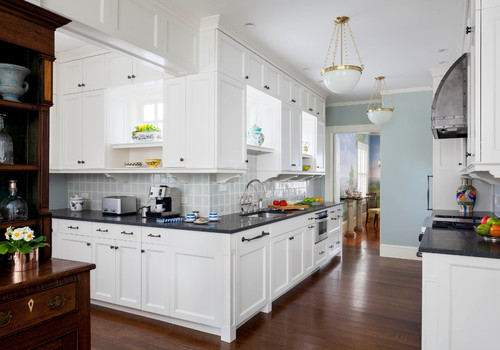
To Buy Kitchen Cabinets – Select Your Cabinet Style
The style of your kitchen cabinets plays a significant role in defining the overall design and atmosphere of your kitchen. Choosing the right cabinet style will ensure a harmonious and cohesive look throughout the space. In this section, we will discuss different cabinet styles and provide tips for selecting the one that best suits your design preferences and kitchen’s overall aesthetic.
A. Types of Cabinet Styles
- Traditional: Traditional cabinets feature intricate detailing, raised panel doors, and ornate molding, often made from rich, dark woods like cherry or mahogany. This style is perfect for those seeking a timeless, classic look in their kitchen.
- Contemporary: Contemporary cabinets are characterized by clean lines, minimal ornamentation, and a focus on functionality. Materials like stainless steel, glass, and laminate are commonly used in this style. If you prefer a sleek, modern aesthetic, contemporary cabinets may be the ideal choice.
- Transitional: Transitional cabinets blend elements of both traditional and contemporary styles, offering a balance between classic and modern design. This style often features streamlined cabinetry with subtle detailing, making it a versatile choice that can complement a wide range of kitchen designs.
- Rustic: Rustic cabinets evoke a warm, cozy ambiance with their distressed finishes, natural wood grains, and handcrafted appearance. Reclaimed wood, knotty pine, and hickory are popular materials for this style. If you want to create a charming, farmhouse-inspired kitchen, rustic cabinets are a great option.
- Shaker: Shaker cabinets are known for their simple, utilitarian design, featuring flat panel doors, clean lines, and minimal ornamentation. Typically made from solid wood or wood veneers, shaker cabinets are versatile and can suit both traditional and contemporary kitchen designs.
B. Matching Your Cabinet Style with Your Kitchen’s Overall Design
When buying cabinets, selecting a cabinet style, it’s essential to consider how it will blend with your kitchen’s overall design, including elements such as countertops, flooring, and appliances. Aim for a cohesive look that reflects your personal style and enhances the visual appeal of your space.
C. Tips for Choosing the Right Cabinet Style
- Assess your design preferences: Evaluate your personal design preferences and consider which cabinet style resonates with you the most.
- Research and gather inspiration: Browse kitchen design websites, magazines, and social media platforms to find inspiration and examples of different cabinet styles in real-life settings.
- Consult a professional: If you’re uncertain about which cabinet style to choose, consider consulting a professional kitchen designer for guidance and advice tailored to your unique space and design vision.
- Visualize your space: Use design tools, software, or even simple sketches to help you visualize how different cabinet styles will look in your kitchen. This can help you make a more informed decision based on the actual appearance of the cabinets in your space.
By carefully considering your design preferences, researching various cabinet styles, and visualizing their impact on your kitchen’s overall aesthetic, you can confidently select the perfect cabinet style to enhance your dream kitchen.
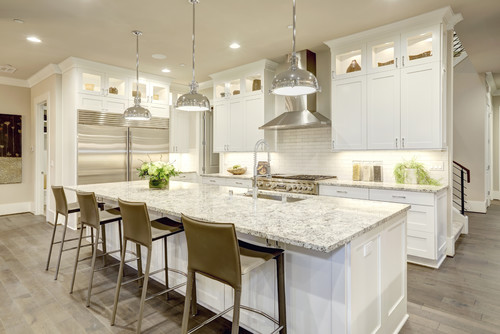
Buy Kitchen Cabinets – Select Cabinet Door Style and Hardware
The cabinet door style and hardware you choose play a significant role in defining the overall appearance and functionality of your kitchen cabinets. In this section, we will discuss various door style options and provide tips for selecting cabinet hardware that complements your chosen style and meets your functional requirements.
A. Door Style Options
- Flat Panel: Flat panel doors feature a simple, unadorned design with clean lines and minimal detailing. This door style is ideal for contemporary and modern kitchens, as it creates a sleek, streamlined appearance.
- Raised Panel: Raised panel doors have a center panel that is elevated, adding depth and dimension to the cabinet door. This style is often used in traditional and transitional kitchens, as it adds an element of elegance and sophistication.
- Recessed Panel: Recessed panel doors have a center panel that is slightly lower than the surrounding frame, creating a subtle, understated look. This door style works well in a variety of kitchen designs, from traditional to contemporary.
- Slab: Slab doors are a single, solid panel without any framing or detailing. This minimalist door style is perfect for modern and contemporary kitchens, as it emphasizes clean lines and simplicity.
- Glass-Front: Glass-front doors feature a glass panel inserted into the cabinet door, allowing you to display your dishware or decorative items. This door style can be used in various kitchen designs, from traditional to contemporary, adding visual interest and a sense of openness to the space.
B. Importance of Cabinet Hardware
Cabinet hardware, including knobs, pulls, and handles, serves both functional and aesthetic purposes. Hardware not only allows you to open and close your cabinet doors and drawers easily but also contributes to the overall style and design of your kitchen. Choosing the right cabinet hardware can enhance the visual appeal of your cabinets and tie together the design elements in your space when buying cabinets.
C. Tips for Selecting Cabinet Hardware
- Match Hardware with Cabinet Style: Ensure that your chosen hardware complements your cabinet style. For example, traditional cabinets may pair well with ornate, antique hardware, while contemporary cabinets may look best with sleek, minimalist hardware.
- Choose Durable and Functional Hardware: Select hardware made from high-quality materials that can withstand daily use. Additionally, consider the functionality of different hardware types, such as knobs versus pulls, and choose the option that best meets your needs.
- Consider Budget and Maintenance: Factor in the cost of cabinet hardware, as it can vary significantly in price depending on the material and design. Additionally, consider the maintenance requirements of your chosen hardware, such as polishing or refinishing.
By carefully considering the door style and hardware for your kitchen cabinets, you can create a cohesive and visually appealing design that not only meets your aesthetic preferences but also ensures smooth and efficient functionality.
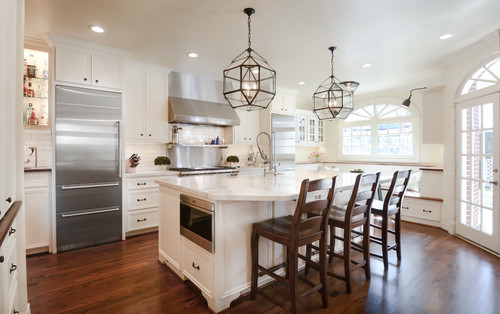
Custom vs. Semi-Custom vs. Stock Cabinets before Buying Cabinets
When you are going to buy kitchen cabinets, it is essential to consider the various types of cabinets available and determine which option best suits your needs, design preferences, and budget. In this section, we will compare custom, semi-custom, and stock cabinets, discuss the pros and cons of each type, and provide guidance on factors to consider when deciding on the most suitable cabinet type for your kitchen.
A. Comparison of Cabinet Types
- Custom Cabinets: Custom cabinets are designed and built to your specific measurements, style preferences, and functional requirements. They offer the most flexibility in terms of design, materials, finishes, and storage options, allowing for a truly personalized kitchen.
- Semi-Custom Cabinets: Semi-custom cabinets offer a balance between customization and affordability. While they are available in a range of standard sizes and styles, they also allow for some level of customization, such as adjusting dimensions, adding specialized storage solutions, or selecting unique finishes.
- Stock Cabinets: Stock cabinets are pre-manufactured in standard sizes and styles and are typically the most budget-friendly option. They are available in a limited range of materials and finishes, with fewer customization options compared to custom or semi-custom cabinets.
B. Pros and Cons of Each Type
- Custom Cabinets:
- Pros: Unlimited design options, high-quality materials and craftsmanship, precise fit for your space, and maximum storage potential.
- Cons: Higher cost, longer lead time for manufacturing and delivery, and potential for increased complexity in the design process.
- Semi-Custom Cabinets:
- Pros: Moderate level of customization, more affordable than custom cabinets, wider range of styles and finishes compared to stock cabinets, and shorter lead time than custom cabinets.
- Cons: Higher cost than stock cabinets, limited customization compared to custom cabinets, and potential for extended lead time compared to stock cabinets.
- Stock Cabinets:
- Pros: Lower cost, faster availability, and ease of purchase and installation.
- Cons: Limited styles, finishes, and sizes, fewer customization options, and potential for lower quality materials and construction compared to custom or semi-custom cabinets.
C. Factors to Consider When Deciding on Cabinet Type
- Budget: Consider your budget when selecting a cabinet type, as the cost can vary significantly between custom, semi-custom, and stock cabinets. Factor in not only the initial purchase price but also long-term maintenance and replacement costs.
- Design Preferences: Evaluate your design preferences and the level of customization you desire in your kitchen cabinets. If you have specific design requirements or want a truly unique kitchen, custom cabinets may be the best option.
- Space and Layout Constraints: Assess the layout of your kitchen and any space constraints that may affect your cabinet choices. Custom cabinets can be designed to fit unique spaces, while stock cabinets may not accommodate unusual dimensions or layouts.
- Time Frame: Consider the time frame for your kitchen renovation and the lead times associated with each cabinet type. Stock cabinets are typically the quickest option, while custom cabinets may require an extended lead time.
By comparing the pros and cons of custom, semi-custom, and stock cabinets and considering factors such as budget, design preferences, space constraints, and time frame, you can make an informed decision on the best cabinet type for your kitchen, ensuring a successful and satisfying renovation experience.
Evaluate Cabinet Features and Storage Solutions
The features and storage solutions incorporated into your kitchen cabinets can have a significant impact on the functionality, organization, and overall usability of your space. In this section, we will discuss essential cabinet features, explore innovative storage solutions, and provide guidance on maximizing space and organization in your kitchen.
A. Essential Cabinet Features
- Durable materials and construction: Opt for cabinets made from high-quality materials with sturdy construction techniques, ensuring long-lasting durability and performance.
- Smooth hardware and drawer glides: Buy kitchen cabinets with high-quality hardware and smooth, full-extension drawer glides, ensuring ease of use and accessibility.
- Adjustable shelving: Look for cabinets with adjustable shelves, allowing you to customize the interior storage space to meet your specific needs.
- Well-finished surfaces: Ensure the cabinets you select have a high-quality, durable finish that protects the material and enhances the overall appearance.
B. Innovative Storage Solutions
- Pull-out shelves: Pull-out shelves provide easy access to items stored in the back of cabinets, making it simple to locate and retrieve your belongings.
- Lazy Susans: Lazy Susans are rotating trays that can be installed in corner cabinets, maximizing storage space and providing easy access to items stored within.
- Corner drawers: Corner drawers are an innovative solution for utilizing often wasted corner spaces, providing additional storage and easy access to kitchen items.
- Appliance garages: Appliance garages are enclosed storage spaces designed to house small appliances, such as toasters or mixers, keeping them out of sight when not in use and maintaining a clean, uncluttered countertop.
C. Maximizing Space and Organization in Your Kitchen
- Assess your storage needs: Before selecting cabinets and storage solutions, take inventory of your kitchen items and determine your specific storage requirements.
- Utilize vertical space: Make the most of the available vertical space in your kitchen by incorporating tall cabinets, stackable shelving, or pegboard systems for hanging items.
- Incorporate multi-functional storage solutions: Look for storage solutions that serve multiple purposes, such as a pull-out cutting board with built-in knife storage or a built-in wine rack that doubles as a display shelf.
- Customize your cabinet interiors: Tailor the interior of your cabinets to your unique needs by incorporating custom storage solutions, such as tray dividers, spice racks, or pot and pan organizers.
By carefully evaluating cabinet features and incorporating innovative storage solutions, you can maximize space and organization in your kitchen, ensuring a functional, efficient, and enjoyable cooking and dining experience.
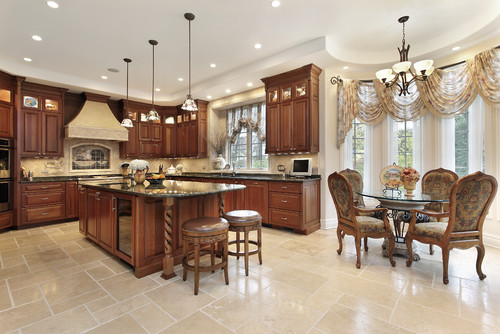
Finding a Reputable Cabinet Supplier when Buying Cabinets
Selecting a reputable cabinet supplier is crucial to ensure that you receive high-quality products, excellent customer service, and a smooth purchasing experience. In this section, we will discuss the process of researching and comparing suppliers, reading reviews and testimonials, seeking recommendations from friends and family, and visiting showrooms to find the best cabinet supplier for your needs.
A. Researching and Comparing Suppliers
- Begin by conducting an online search for cabinet suppliers in your area, making a list of potential candidates that offer the type of cabinets you are interested in.
- Review each supplier’s website to gather information on their product offerings, pricing, and services, such as design consultations or installation support.
- Compare the suppliers on your list, considering factors such as product variety, customization options, pricing, and any additional services offered.
B. Reading Reviews and Testimonials
- Seek out customer reviews and testimonials for each cabinet supplier on your list, looking for feedback on product quality, customer service, and overall satisfaction.
- Pay attention to any recurring themes or concerns mentioned in the reviews, as they may indicate potential issues with the supplier.
- Keep in mind that no supplier will have exclusively positive reviews; however, a reputable supplier should have a majority of satisfied customers and a demonstrated commitment to addressing any concerns.
C. Asking for Recommendations from Friends and Family
- Reach out to friends, family members, or colleagues who have recently purchased kitchen cabinets or undergone a kitchen renovation, asking for their recommendations and experiences with local cabinet suppliers.
- Inquire about their satisfaction with the cabinets they purchased, the level of customer service they received, and any issues they encountered during the purchasing process.
- Use the feedback from your personal network to supplement your online research and further refine your list of potential cabinet suppliers.
D. Visiting Showrooms
- Once you have narrowed down your list of potential cabinet suppliers, visit their showrooms or designated display areas at home improvement stores to view their products in person.
- Take note of the quality of the materials, craftsmanship, and finishes, ensuring that they meet your expectations and preferences.
- Engage with sales representatives or design consultants at each showroom, asking questions about their products, customization options, and any additional services they offer. Assess their knowledge, professionalism, and willingness to help you find the best cabinets for your needs.
By thoroughly researching and comparing cabinet suppliers, reading reviews and testimonials, seeking personal recommendations, and visiting showrooms, you can confidently select a reputable cabinet supplier that will provide you with high-quality products and an exceptional customer experience, ensuring a successful kitchen renovation project.
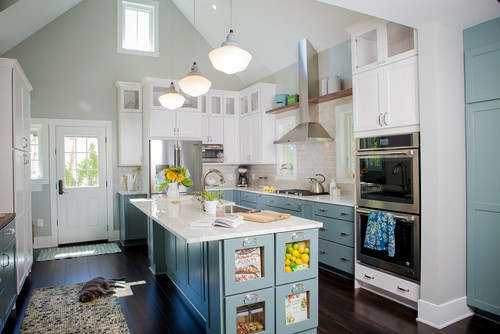
Professional Installation vs. DIY after Buying Cabinets
When it comes to installing your new kitchen cabinets, you have two primary options: hiring a professional contractor or tackling the project yourself. In this section, we will discuss the pros and cons of each option, factors to consider when deciding on an installation method, and tips for ensuring a successful installation.
A. Pros and Cons of Each Option
- Professional Installation:
- Pros: Expertise and experience, proper alignment and fit, adherence to local building codes, reduced risk of damage or mistakes, and a stress-free experience.
- Cons: Higher cost, potential scheduling challenges, and reliance on a third party for quality and timeliness.
- DIY Installation:
- Pros: Lower cost, greater control over the project, personal satisfaction of completing the work yourself, and flexibility in scheduling.
- Cons: Requires carpentry and home improvement skills, potential for mistakes or damage, time-consuming, and responsibility for adhering to local building codes.
B. Factors to Consider When Deciding on Installation Method
- Skill Level: Be honest about your carpentry and home improvement skills when deciding whether to hire a professional or attempt a DIY installation. Consider the potential risks and challenges associated with each option.
- Budget: Take your budget into account when selecting an installation method, weighing the cost of professional installation against the potential savings of a DIY project. Remember that mistakes made during a DIY installation may require additional repairs or adjustments, potentially increasing the overall cost.
- Time Availability: Consider the time you have available to dedicate to the project. DIY installations can be time-consuming, while professional installations may require coordinating with a contractor’s schedule.
- Complexity of the Project: Evaluate the complexity of your kitchen cabinet installation, considering factors such as the size of your kitchen, the type of cabinets, and any unique layout or design elements that may require specialized skills or tools.
C. Tips for a Successful Installation
- Plan Ahead: Whether you choose professional installation or DIY, take the time to plan your project thoroughly, considering factors such as cabinet layout, measurements, and any necessary modifications or adjustments.
- Prepare Your Workspace: Before beginning the installation, clear and prepare your workspace, ensuring you have adequate space to work and access to any necessary tools or materials.
- Follow Manufacturer’s Instructions: Carefully follow the manufacturer’s instructions for installing your cabinets, paying close attention to details such as hardware placement, leveling, and securing methods.
- Seek Assistance if Needed: If you encounter challenges or are unsure about any aspect of the installation process, do not hesitate to seek assistance from a professional or knowledgeable friend or family member.
By carefully weighing the pros and cons of professional installation versus DIY, considering factors such as skill level, budget, and project complexity, and following tips for a successful installation, you can ensure a smooth and satisfying experience when installing your new kitchen cabinets.
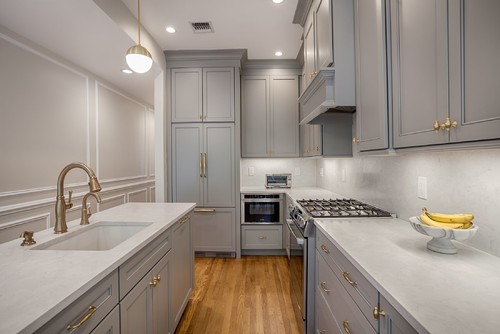
Kitchen Cabinet Color and Finish Options
Selecting the right color and finish for your kitchen cabinets can greatly impact the overall look and feel of your space. In this section, we will explore popular color choices for cabinets, discuss the various types of cabinet finishes, and provide tips for choosing the right color and finish for your kitchen.
A. Popular Color Choices for Cabinets
- White: White cabinets provide a clean, timeless look that can brighten up your kitchen and make the space feel larger.
- Gray: Gray cabinets offer a versatile, neutral option that can complement various design styles, from modern to traditional.
- Natural Wood Tones: Cabinets in natural wood tones, such as oak, cherry, or maple, bring warmth and a classic, natural feel to your kitchen.
- Bold Colors: Bold cabinet colors, such as navy blue, emerald green, or deep red, can create a striking focal point and add personality to your kitchen.
B. Types of Cabinet Finishes
- Painted: Painted cabinets offer a smooth, uniform appearance and can be finished in a virtually unlimited range of colors.
- Stained: Stained cabinets highlight the natural grain and texture of the wood while providing a rich, deep color.
- Glazed: Glazed cabinets feature a layer of translucent glaze applied over paint or stain, adding depth and dimension to the finish.
- Distressed: Distressed cabinets have an intentionally aged or weathered appearance, created through various techniques such as sanding or applying antiquing glazes.
- Laminate: Laminate cabinets consist of a durable, low-maintenance material that mimics the appearance of wood or other finishes.
C. Tips for Choosing the Right Color and Finish
- Consider Your Kitchen’s Overall Design: Take into account the overall design of your kitchen, including your countertops, backsplash, flooring, and appliances, when selecting a cabinet color and finish. Aim for a cohesive look that complements and balances other elements in the space.
- Factor in Natural Lighting: Consider the amount of natural light in your kitchen when choosing a cabinet color, as lighter colors can help brighten dark spaces, while darker colors may add warmth and depth to a room with abundant natural light.
- Test Samples in Your Space: Obtain samples of cabinet colors and finishes, and test them in your kitchen under various lighting conditions to see how they look in your space. This will help you make a more informed decision when selecting your final cabinet color and finish.
- Balance with Other Elements in the Kitchen: When choosing a bold or dramatic cabinet color, consider balancing it with neutral or understated elements, such as countertops and backsplashes, to prevent the space from feeling visually overwhelming.
By considering popular color choices and cabinet finishes, and following tips for selecting the right color and finish for your space, you can create a kitchen that reflects your personal style and enhances the overall aesthetic of your home.
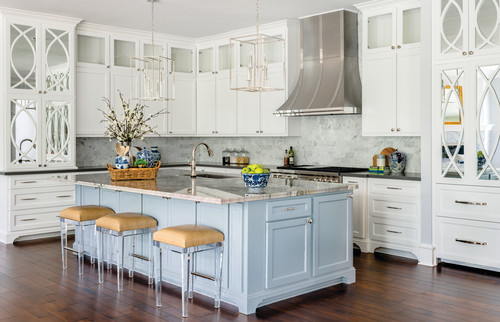
Green and Eco-friendly Kitchen Cabinet Options during Buying Cabinets
As environmental concerns continue to grow, many homeowners are seeking eco-friendly alternatives for their home renovations, including kitchen cabinets. In this section, we will discuss the importance of eco-friendly cabinets, explore sustainable materials, examine low-VOC and formaldehyde-free options, and highlight energy-efficient and eco-friendly cabinet features.
A. Importance of Eco-friendly Cabinets
- Environmental Impact: Eco-friendly cabinets help minimize the environmental impact of your kitchen renovation, reducing the depletion of natural resources, pollution, and waste generation.
- Indoor Air Quality: Cabinets made from eco-friendly materials and finishes can contribute to improved indoor air quality, reducing the presence of harmful chemicals and off-gassing.
- Longevity: Eco-friendly cabinets often prioritize durability and quality craftsmanship, resulting in a longer-lasting product that requires fewer replacements over time.
B. Sustainable Materials
- Bamboo: Bamboo cabinets are made from a rapidly renewable resource that regenerates quickly, making it an environmentally friendly choice. It is also strong, durable, and resistant to moisture and warping.
- Reclaimed Wood: Reclaimed wood cabinets are crafted from salvaged or recycled wood, reducing the demand for new lumber and decreasing deforestation. This material can add character and a unique, rustic appearance to your kitchen.
- FSC-certified Wood: Forest Stewardship Council (FSC) certification ensures that the wood used for your cabinets comes from responsibly managed forests that prioritize sustainable practices and long-term conservation.
C. Low-VOC and Formaldehyde-free Options
- Low-VOC (volatile organic compounds) finishes, such as water-based paints and stains, can help reduce off-gassing and improve indoor air quality.
- Formaldehyde-free cabinets utilize alternative materials, such as plywood made without formaldehyde or solid wood construction, to minimize the release of harmful chemicals into your home.
D. Energy-efficient and Eco-friendly Cabinet Features
- LED Lighting: Integrating energy-efficient LED lighting into your cabinets can reduce energy consumption and lower your utility bills.
- Water-based Adhesives: Opt for cabinets that use water-based adhesives rather than solvent-based adhesives, which can emit harmful VOCs.
- Soft-close Hinges and Drawer Glides: Soft-close hinges and drawer glides can reduce wear and tear on your cabinets, prolonging their lifespan and reducing waste.
By selecting eco-friendly kitchen cabinet options made from sustainable materials, incorporating low-VOC and formaldehyde-free finishes, and prioritizing energy-efficient and environmentally friendly features, you can create a greener, healthier kitchen that benefits both your family and the planet.
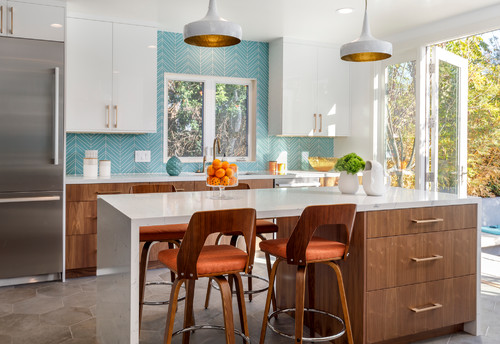
Planning and Measuring Your Kitchen Space before you Buy Kitchen Cabinets
Accurate planning and measuring of your kitchen space is essential for a successful cabinet installation and overall kitchen renovation. In this section, we will discuss the importance of accurate measurements, provide tips for measuring your kitchen, explore creating a kitchen layout, and consider working with a professional kitchen designer.
A. Importance of Accurate Measurements
- Proper Fit: Accurate measurements ensure that your cabinets will fit correctly in your kitchen, preventing issues such as misaligned doors or drawers and gaps between cabinets.
- Optimal Functionality: Precise measurements contribute to a well-planned layout, promoting efficient use of your kitchen space and improving overall functionality.
- Cost Savings: Proper measurements can help prevent costly mistakes and additional labor, as well as reduce material waste.
B. Tips for Measuring Your Kitchen
- Use a Steel Tape Measure: Utilize a steel tape measure for the most accurate measurements, as fabric or plastic tape measures can stretch or become distorted.
- Measure Walls and Obstructions: Measure the length of each wall in your kitchen, as well as the height and width of any obstructions, such as windows, doors, or appliances.
- Note Electrical Outlets and Plumbing: Mark the locations of electrical outlets, light switches, and plumbing fixtures on your layout plan, as these will impact the placement of cabinets and other elements.
- Double-check Measurements: Always double-check your measurements to ensure accuracy and prevent errors.
C. Creating a Kitchen Layout
- Determine the Layout Style: Consider the best layout style for your kitchen, such as a galley, L-shaped, or U-shaped configuration, based on factors like available space, workflow, and personal preferences.
- Consider the Work Triangle: Keep the work triangle—comprised of the refrigerator, sink, and cooktop—in mind when planning your layout, as this will improve efficiency and workflow in your kitchen.
- Plan for Storage and Functionality: Incorporate adequate storage and functional features, such as drawers, pull-out shelves, and appliance garages, to maximize the usability of your kitchen.
- Allow for Sufficient Clearance: Ensure that there is enough clearance for cabinet doors, drawers, and appliances to open fully without obstructing walkways or other elements.
D. Working with a Professional Kitchen Designer
- Expertise and Experience: A professional kitchen designer can provide valuable insight and guidance based on their expertise and experience in kitchen design.
- Customized Solutions: Working with a designer allows for a more personalized and tailored approach to your kitchen layout, addressing unique challenges and preferences.
- Access to Resources: Professional designers often have access to exclusive resources, such as premium materials or specialized vendors, that can enhance the quality and aesthetics of your kitchen.
- Coordinated Project Management: A kitchen designer can help manage and coordinate the various aspects of your renovation, from cabinet selection and layout planning to coordinating with contractors and ensuring a smooth installation process.
By accurately measuring your kitchen space, creating a well-planned layout, and considering the option of working with a professional kitchen designer, you can ensure a successful kitchen renovation that results in a beautiful and functional space tailored to your needs.
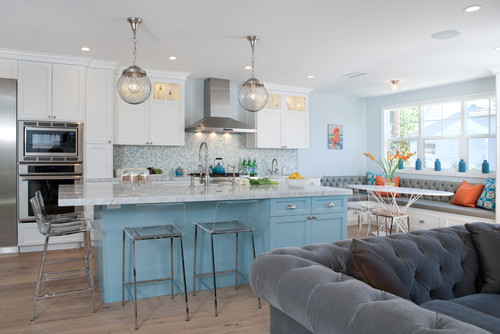
Maximizing Your Kitchen Cabinet Investment for Buying Cabinets
Investing in new kitchen cabinets is a significant financial undertaking. It is essential to maximize your investment by ensuring the cabinets remain in excellent condition for years to come. In this section, we will discuss proper cabinet care and maintenance, periodic adjustments and touch-ups, and when to consider refacing or replacing cabinets.
A. Proper Cabinet Care and Maintenance
- Cleaning: Regularly clean your cabinets with a soft, damp cloth and a mild detergent or soap, taking care not to use abrasive cleaners or sponges that can damage the finish. Wipe up spills and splatters immediately to prevent staining or damage.
- Protect from Moisture: Minimize prolonged exposure to water or humidity, as this can cause warping or damage to the cabinet finish. Ensure proper ventilation in your kitchen and use a range hood to remove steam and cooking vapors.
- Avoid Direct Sunlight: Protect your cabinets from direct sunlight, which can cause fading or discoloration over time. Consider installing window coverings or UV-resistant film to minimize sun exposure.
B. Periodic Adjustments and Touch-ups
- Check Hinges and Hardware: Periodically inspect and tighten hinges, knobs, and pulls to ensure proper function and prevent damage.
- Adjust Doors and Drawers: Over time, cabinet doors and drawers may require adjustments to maintain proper alignment and function. Make necessary adjustments using the provided hinge screws or drawer glide mechanisms.
- Touch-up Paint or Stain: Address minor scratches, dings, or wear in the cabinet finish with a touch-up kit provided by the manufacturer or a closely matched paint or stain.
C. When to Consider Refacing or Replacing Cabinets
- Refacing: If your cabinet boxes are in good condition, but the doors, drawers, or finish are outdated or damaged, consider refacing your cabinets. Refacing involves replacing the cabinet doors, drawer fronts, and hardware, and applying a new veneer to the cabinet boxes.
- Replacing: Consider replacing your cabinets if they are structurally compromised, have significant water damage, or if the layout and functionality of your kitchen no longer meet your needs. Additionally, if the cost of refacing is similar to or exceeds the cost of new cabinets, replacement may be a more cost-effective option.
By following proper care and maintenance guidelines, periodically adjusting and touching up your cabinets, and knowing when to consider refacing or replacing, you can maximize the longevity and value of your kitchen cabinet investment.
Key Takeaways and Next Steps for Buying Cabinets
As you embark on the journey of purchasing and installing new kitchen cabinets, it’s essential to keep in mind several crucial factors to ensure a successful renovation. In this final section, we’ll recap the important aspects of buying kitchen cabinets, encourage you to begin the cabinet selection process, provide resources for additional research and inspiration, and share our excitement for your upcoming kitchen transformation.
A. Recap of Important Factors in Buying Kitchen Cabinets
- Budget: Establish a clear budget that considers all aspects of your kitchen renovation, including cabinets, countertops, appliances, and labor costs.
- Material and Quality: Consider the quality and material of the cabinets, as well as factors like durability, longevity, and ease of maintenance.
- Cabinet Types: Weigh the pros and cons of custom, semi-custom, and stock cabinets to determine the best option for your needs and budget.
- Features and Storage Solutions: Evaluate cabinet features and innovative storage solutions to maximize space and organization in your kitchen.
- Supplier and Installation: Research reputable cabinet suppliers and decide whether to opt for professional installation or a DIY approach.
- Color and Finish: Choose the right color and finish for your cabinets based on your kitchen’s overall design, lighting, and personal preferences.
- Eco-friendly Options: Explore green and eco-friendly cabinet materials and features to create a more sustainable kitchen.
- Planning and Measuring: Accurately measure your kitchen space and work with a professional designer, if desired, to create an efficient and functional layout.
B. Encouragement to Begin the Cabinet Selection Process
Now that you are equipped with the knowledge and tools to make informed decisions, it’s time to start the cabinet selection process. Begin by researching suppliers, visiting showrooms, and exploring design ideas that align with your vision for your new kitchen.
C. Resources for Additional Research and Inspiration
- Home Improvement Websites: Browse home improvement websites and blogs for design ideas, product reviews, and expert advice.
- Social Media and Design Platforms: Utilize platforms like Pinterest, Instagram, and Houzz to find inspiration and gather ideas for your kitchen renovation.
- Showrooms and Home Improvement Stores: Visit local showrooms and home improvement stores to see and feel cabinet options in person and consult with knowledgeable staff.
D. Excitement for Your Upcoming Kitchen Transformation
Your kitchen renovation journey is an exciting one, full of possibilities and opportunities to create a space that reflects your personal style and meets your needs. As you progress through the cabinet selection and installation process, remember to stay true to your vision and enjoy the process of transforming your kitchen into a beautiful, functional, and inviting space for you and your loved ones to enjoy for years to come.
Conclusion
The process of selecting and installing new kitchen cabinets can be both exciting and overwhelming. By following the comprehensive guide provided in this blog post, you can make informed decisions and create a kitchen that is both functional and aesthetically pleasing. Remember to consider factors such as budget, cabinet quality, materials, eco-friendly options, and storage solutions while planning your kitchen layout and selecting the right supplier and installation method. With careful planning and execution, your kitchen renovation will result in a beautiful and inviting space that enhances your home and brings joy to your everyday life. Happy renovating!
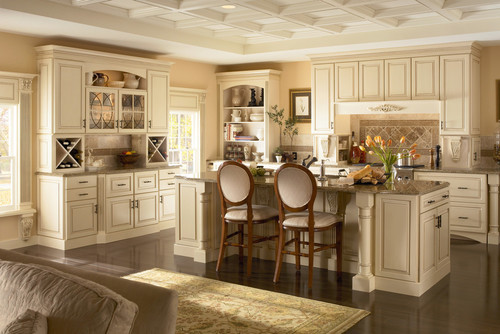
FAQs about How to Buy Kitchen Cabinets
Q: What factors should I consider when buying kitchen cabinets?
A: Consider factors such as budget, material and quality, cabinet type (custom, semi-custom, or stock), features and storage solutions, color and finish, eco-friendliness, accurate measurements, and working with a professional designer if needed.
Q: What are the differences between custom, semi-custom, and stock cabinets?
A: Custom cabinets are made-to-order, offering the highest level of customization and quality but at a higher price. Semi-custom cabinets provide a balance between customization and cost, with a range of styles and options to choose from. Stock cabinets are the most affordable option, but have limited choices in terms of style, size, and features.
Q: How can I maximize the space and organization in my kitchen?
A: Incorporate innovative storage solutions such as pull-out shelves, Lazy Susans, corner drawers, and appliance garages. Evaluate cabinet features and opt for designs that suit your storage needs and preferences.
Q: How do I maintain my kitchen cabinets?
A: Regularly clean your cabinets with a soft, damp cloth and mild detergent. Protect them from moisture and direct sunlight. Periodically inspect and tighten hinges, knobs, and pulls, and adjust doors and drawers as needed. Touch up paint or stain if minor scratches or dings appear.
Q: When should I consider refacing or replacing my cabinets?
A: Consider refacing if your cabinet boxes are in good condition, but the doors, drawers, or finish are outdated or damaged. Replace cabinets if they are structurally compromised, have significant water damage, or if the layout and functionality of your kitchen no longer meet your needs. Also, consider replacement if the cost of refacing is similar to or exceeds the cost of new cabinets.
Q: What are some eco-friendly options for kitchen cabinets?
A: Look for sustainable materials like bamboo, reclaimed wood, or FSC-certified wood. Choose low-VOC and formaldehyde-free finishes, and incorporate energy-efficient features like LED lighting and water-based adhesives.
Q: How do I choose the right color and finish for my kitchen cabinets?
A: Consider your kitchen’s overall design, factor in natural lighting, test color samples in your space, and balance the chosen color with other elements in the kitchen. Popular finishes include painted, stained, glazed, distressed, and laminate.
Q: What are the benefits of working with a professional kitchen designer?
A: Professional kitchen designers provide valuable expertise and experience, offer personalized solutions, have access to exclusive resources, and can help manage and coordinate various aspects of your renovation project.
Q: How do I accurately measure my kitchen space for cabinets?
A: Use a steel tape measure for accurate measurements, measure walls and obstructions, note electrical outlets and plumbing fixtures, and double-check your measurements to ensure accuracy.
Q: What resources can I use for additional research and inspiration?
A: Browse home improvement websites, use social media and design platforms like Pinterest, Instagram, and Houzz, and visit local showrooms and home improvement stores to find design ideas, product reviews, and expert advice.
Q: Can I install kitchen cabinets myself, or should I hire a professional?
A: Both options have their pros and cons. DIY installation can save money but requires time, skill, and proper tools. Professional installation ensures a high-quality result, but it can be more expensive. Consider factors such as your budget, skill level, and the complexity of the project when deciding on an installation method.


